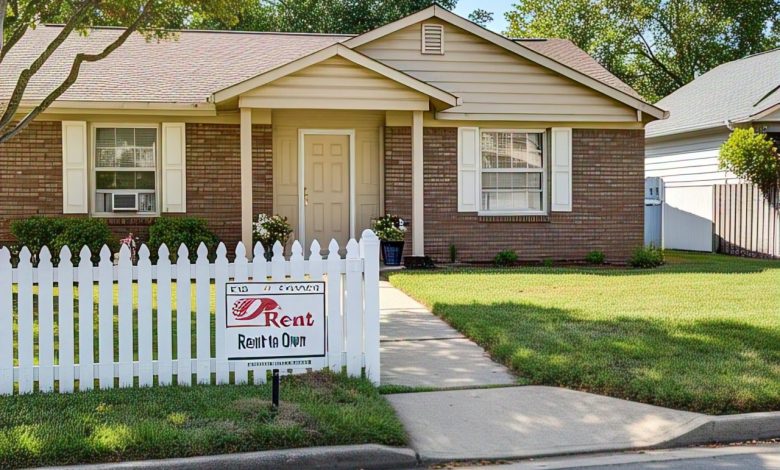
Let me tell you why I decided to write about rent-to-own homes. A few years ago, I found myself stuck between wanting to buy a home and not being able to afford a huge down payment. I kept hearing about this “rent-to-own” concept but couldn’t find clear, honest info that truly explained how it all worked. Most articles were either too technical or just repeated the same vague tips.
So, I dove deep. I learned everything I could about how rent-to-own works, what the pros and cons were, and even spoke with people who had gone through the process. Today, I want to share that knowledge with you—clearly, simply, and from personal experience.
The goal of this blog post is to break things down for regular folks—especially if you’re trying to figure out a way to own a home but don’t know where to start. We’ll look at how rent-to-own homes work in 2025, their benefits and risks, and what you need to know before signing anything.
1. What Are Rent-to-Own Homes and Why Are They Gaining Popularity?
Rent-to-own homes are exactly what they sound like—you rent a house with the option to buy it later. It’s kind of like putting a home on layaway. These deals are especially popular among people who may not qualify for a mortgage right now but hope to in a few years.
You’ll typically enter a contract that allows you to live in the home as a renter, but with the exclusive option to purchase it at a fixed price after a set period (usually 1 to 5 years). This is what’s known as a lease option agreement.
What’s making these deals more popular in 2025? It’s a mix of rising home prices, student loan debt, and tighter lending rules. Many families just don’t have the 20% down payment saved up. A rent-to-own home lets them move in now and buy later—giving them time to save and build their credit.
Pro Tip: Make sure your lease spells out the purchase price and any upfront option fee. Get everything in writing to avoid future problems.
2. How Rent-to-Own Works: A Simple Step-by-Step Breakdown
Let’s walk through exactly how rent-to-own works so there’s no confusion.
Step 1: The Agreement
You and the seller sign a lease option agreement. This includes:
-
Monthly rent amount
-
Option-to-buy fee (usually 1-5% of home price)
-
Final purchase price
-
Agreement term (usually 1–3 years)
Step 2: Paying Rent + Rent Credits
Each month, you pay rent like normal—but a portion may go into a “rent credit” that can count toward your down payment if you buy. This is called a rent credit program.
Step 3: Time to Buy
When the lease ends, you can:
-
Buy the home at the agreed price, using your rent credits.
-
Walk away (but you might lose your option fee and credits).
Here’s a quick comparison table to help make this clearer:
| Term | Description |
|---|---|
| Lease Option | Right (but not obligation) to buy the home later |
| Option Fee | One-time, non-refundable payment |
| Rent Credit | Portion of rent put toward purchase |
| Purchase Price | Locked-in at time of agreement |
Quick Tip: Never skip a payment. Missing rent can void your option to buy. Keep records of all rent and credits.
3. What’s Inside a Lease Option Agreement? Let’s Break It Down
A lease option agreement is the legal contract that makes everything official. I’ve seen many folks skip over the fine print—but trust me, this is where the deal can either protect you or burn you.
Here are the key parts you need to check:
-
Option fee: This is your ticket to buy later. If you don’t buy, you usually don’t get it back.
-
Purchase price: It’s locked in now, even if the market goes up.
-
Rent credit clause: This part defines how much of your rent applies toward the purchase.
-
Maintenance: In many deals, tenants handle basic repairs.
-
Deadlines: Know the exact date your option to buy expires.
And always ask—what happens if you back out? Some sellers keep the option fee and rent credits if you choose not to buy.
Guide: Hire a real estate attorney before signing any lease option. Yes, it’s an extra cost, but they’ll save you thousands by spotting issues early.
4. How Rent Credit Programs Work and Why They Matter
The rent credit program can either be your best friend—or a disappointment—depending on how your contract is written.
Let’s say your rent is $1,500/month. If $300 goes toward a rent credit, and you rent for 3 years, you’ve built up $10,800 toward your future down payment. That’s a big deal.
But here’s the catch: not all deals offer rent credit, and some only give you a small amount. And if you miss payments, you might lose the credit altogether.
Here are common types of rent credits:
-
Fixed credit: A set amount each month (e.g., $200/month)
-
Percentage credit: Based on a portion of your rent (e.g., 20%)
Note: Rent credits don’t count toward equity until you officially buy the home. They’re basically “future value.”
Pro Tip: Ask for a monthly rent credit log from your landlord. It’ll help keep everything transparent.
5. What Are the Pros of Rent-to-Own Homes in 2025?
There are some clear wins with rent-to-own homes, especially if you’re not quite mortgage-ready yet. Here’s why people go for them:
-
Lower upfront cost: You don’t need 20% down like traditional home buying.
-
Time to improve credit: Rent while you build a better credit score.
-
Lock-in today’s price: Beat future real estate inflation.
-
Try before you buy: You get to live in the house before fully committing.
And if you’re in a competitive housing market, this is a smart way to “reserve” a home while you get your finances in shape.
Quick Tip: Use the lease period to speak with a mortgage lender and see how close you are to qualifying. You’ll thank yourself later.
6. What Are the Cons and Risks of Rent-to-Own Homes?
Like any deal that sounds great, rent-to-own homes have their downsides too. You’ve got to be smart and realistic.
Here are the main risks:
-
You might not qualify for a mortgage later.
-
You lose the option fee and rent credits if you don’t buy.
-
You’re responsible for repairs—sometimes big ones.
-
The seller could default or sell to someone else if the contract isn’t airtight.
According to the Consumer Financial Protection Bureau (CFPB), many rent-to-own agreements lack oversight and protections that come with mortgages. That’s why it’s so important to have legal help before signing.
Guide: Don’t assume you’ll qualify for a loan later—start working with a lender as soon as you enter the lease. If you wait, it could be too late.
7. How Government Rules and Market Trends Affect Rent-to-Own Deals in 2025
Let’s talk real-world: 2025 has brought new laws and changing market trends that directly impact rent-to-own homes.
For example, some states like California and New York have started regulating lease options more strictly to protect renters from scams. The National Association of Realtors has also issued new guidelines to improve transparency in these agreements.
At the same time, the Federal Reserve’s interest rate policies are making traditional loans harder to get, pushing more people toward rent-to-own as a backup plan.
According to a recent report from the Urban Institute, rent-to-own agreements are growing fastest in urban areas where home prices have jumped over 30% since 2020.
Pro Tip: Always check your state’s real estate laws. Some states require disclosures or special clauses in lease option agreements.
8. How to Know If a Rent-to-Own Deal Is Right for You
This is the big question. Is rent-to-own right for you? It depends on your situation.
Here’s a simple checklist to help you decide:
- You don’t qualify for a mortgage yet, but will soon
- You’ve found a property and want to lock in the price
- You can afford the rent and option fee
- You’re committed to buying within 1–3 years
- You’re willing to take the risk if the deal falls through
And here’s when it’s not a good idea:
- You’re unsure about staying long-term
- Your income is unstable
- You don’t fully trust the seller
- You don’t have a real estate lawyer reviewing the contract
Quick Tip: Treat this like buying a home—not just renting. Inspect the home. Research the area. Talk to neighbors. Go all in.
Final Thoughts
Rent-to-own homes can be a real opportunity in 2025—but only if you walk in with eyes wide open. We’ve talked about how rent-to-own works, the ins and outs of lease option agreements, and how rent credit programs can make or break the deal.
If you’re serious about owning a home and need a stepping stone, this might be it. But always protect yourself legally and financially. My advice? Don’t rush it. Get educated, stay realistic, and use this post as your starting point.
Got questions or experiences with rent-to-own? Drop them in the comments—I’d love to hear your story and help if I can.
